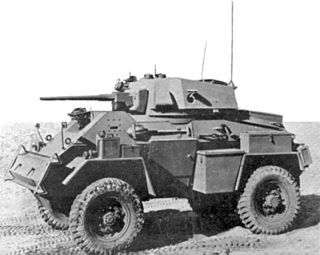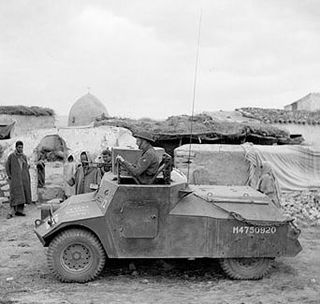
The T-26 tank was a Soviet light tank used during many conflicts of the Interwar period and in World War II. It was a development of the British Vickers 6-Ton tank and was one of the most successful tank designs of the 1930s until its light armour became vulnerable to newer anti-tank guns. It was produced in greater numbers than any other tank of the period, with more than 11,000 units manufactured. During the 1930s, the USSR developed 53 variants of the T-26, including flame-throwing tanks, combat engineer vehicles, remotely controlled tanks, self-propelled guns, artillery tractors, and armoured carriers. Twenty-three of these were series-produced, others were experimental models.

The Tank, Infantry, Mk III, Valentine was an infantry tank produced in the United Kingdom during World War II. More than 8,000 of the type were produced in eleven marks, plus various specialised variants, accounting for approximately a quarter of wartime British tank production. The many variants included riveted and welded construction, petrol and diesel engines and a progressive increase in armament. It was supplied in large numbers to the USSR and built under licence in Canada. It was used extensively by the British in the North African campaign. Developed by Vickers, it proved to be both strong and reliable, which was unusual for British tanks of the period.

The Daimler Armoured Car was a successful British armoured car design of the Second World War that continued in service into the 1950s. It was designed for armed reconnaissance and liaison purposes. During the postwar era, it doubled as an internal security vehicle in a number of countries.

The Humber Armoured Car was one of the most widely produced British armoured cars of the Second World War. It supplemented the Humber Light Reconnaissance Car and remained in service until the end of the war.

AEC Armoured Car is the name of a series of British heavy armoured cars built by the Associated Equipment Company (AEC) during World War II.

The Daimler Scout Car, known in service as the Daimler Dingo, was a British light, fast four-wheel drive reconnaissance vehicle also used for liaison during the Second World War.

The Light Tank Mark I to Mark V were a series of related designs of light tank produced by Vickers for the British Army during the interwar period.

Guy Motors was a Wolverhampton-based vehicle manufacturer that produced cars, lorries, buses and trolleybuses. The company was founded by Sydney S. Guy (1885–1971) who was born in Kings Heath, Birmingham. Guy Motors operated out of its Fallings Park factory from 1914 to 1982, playing an important role in the development of the British motor industry.

The Marmon-Herrington Armoured Car was a series of armoured vehicles that were produced in South Africa and adopted by the British Army during the Second World War. RAF Armoured Car companies possessed them, but seem never to have used them in action, making greater use of Rolls Royce Armoured Cars and other types.

An artillery tractor, also referred to as a gun tractor, is a specialized heavy-duty form of tractor unit used to tow artillery pieces of varying weights and calibres. It may be wheeled, tracked, or half-tracked.

The Humber Scout Car was a British light scout car used in the Second World War. It entered service in 1942 and continued in production until 1945. Designed for reconnaissance, and liaison between armoured units, it provided protection only against light arms fire, so was not a front line vehicle. More importantly it was small and fast and could quickly evade trouble. It became the shape format for the post war Ferret armoured car which began production in 1952.

The Humber Light Reconnaissance Car, also known as Humberette or Ironside, was a British armoured car produced during the Second World War.

Morris Light Reconnaissance Car (LRC) was a British light armoured car for reconnaissance use produced by Morris Motors Limited and used by the British during the Second World War.

Standard Car 4x2, or Car Armoured Light Standard, better known as the Beaverette, was a British armoured car produced during the Second World War.

The Coventry armoured car (AFVW19) was a British four wheel drive armoured fighting vehicle developed at the end of the Second World War as a potential replacement for the lighter Humber and Daimler armoured cars.
This article lists British armoured fighting vehicle production during the Second World War. The United Kingdom produced 27,528 tanks and self-propelled guns from July 1939 to May 1945, as well as 26,191 armoured cars and 69,071 armoured personnel carriers.
Tanks of the Second World War

Throughout its history, the Irish Army has used a number of armoured fighting vehicles.

















